Double Height DDR4: 32GB Modules from G.Skill and ZADAK Reviewed
by Ian Cutress & Gavin Bonshor on January 23, 2019 9:00 AM ESTDouble Height DDR4 Conclusion
In this review we have tested the new 32 GB DDR4 modules from both G.Skill and Zadak. These modules are 'double the height' of traditional DDR4 memory, as they essentially use two modules worth of DRAM chips to achieve the double capacity. The modules do this through adjusting the pins on the DDR4 interface as if one memory slot were responsible for two memory sticks. This change means that these modules need to be qualified for motherboards on a per-motherboard basis. To that extent, at the time of the review, these modules are only validated on three ASUS ROG motherboards. These are enthusiast grade motherboards, to go along with enthusiast grade memory.
The benefit of these 32 GB DDR4 modules means that a motherboard with only two memory slots can achieve 64 GB of memory by using 2x32 GB, rather than the current limit of 2x16 GB. The penalty for using the memory comes in the form of physical space on the motherboard - the G.Skill kit we tested is substantially taller than its regular counterpart, while the Zadak kit we tested is marginally taller. In both circumstances, the manufacturers recommend that liquid cooling is used on the processor on the motherboard, given the difficulty that air coolers can have with tall memory.
On the modules we get a doubling of almost everything: there are 32 Samsung B-die chips on each module, leading to 32 GB of capacity per module. There is also double EPROMs, and when installed in the system, each module is seen as two. What we essentially have is the 'two DIMMs per channel' technique exploited by having two DIMMs on one PCB.
The purpose of this review was to examing the hardware, and test to see if there are any performance differences. Also, the presence of Samsung B-die gave us an interesting application - these high-performance chips are usually an overclockers' favorite, so we did a bit of overclocking as well. We also looked into power, which is likely to be a sticking point for these modules.
Performance
Performance across both the G.Skill and ZADAK kits was consistent in our bench suite, and on par with G.Skill's TridentZ RGB DDR4-3200 standard 2x16 GB kit. Before we started, one could have assumed that the double height memory would hinder performance due to its larger size longer traces from the ICs, EPROM and pins - however having a unified design actually seemed to benefit in a few of the scenarios.
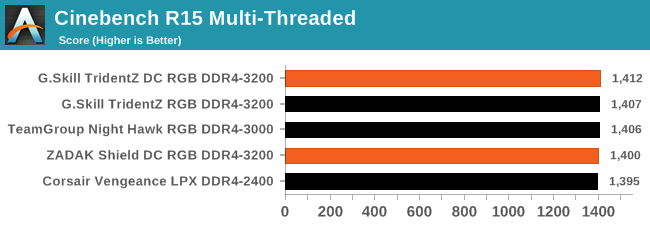
For power, we tested using Intel's Power Gadget tool, which has the hooks to test DDR4. The results show have two interesting scenarios. For power consumed per gigabyte, the new memory is fairly competitive:
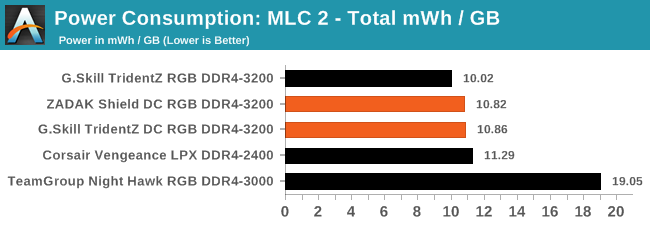
However, when we look at power per performance, in a benchmark where all the memory kits performed the same, then the value only comes from having the larger memory:
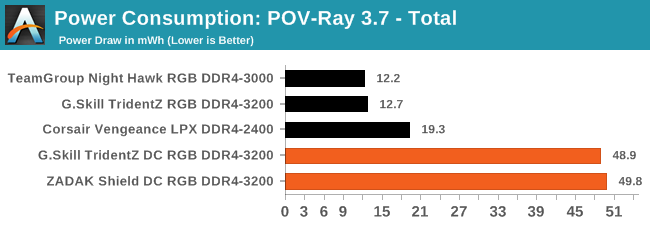
Compatibility
As mentioned, only three ASUS motherboards currently support this new double height DDR4 memory. It means these modules are going after a small market, or it will be up to system integrators to get the best deals for end-users when combining the right motherboard with the right memory. ASUS is keeping the details of how they enabled the new memory under wraps for now, likely seeing it as a competitive advantage in the aggressive motherboard market.
In the ASUS BIOSes, there's nothing much that gives them away, except that the BIOS shows that four memory slots are populated, despite the motherboard only having two available, confirming that each of these 32 GB memory modules are seen internally as 2x16GB modules.
Double Capacity, Double The Price
On the pricing front, this is down to the memory companies. G.Skill doesn't typically give official pricing for any of its kits, and the company states they like to be competitive per region on a weekly basis, which means they don't give 'global MSRPs' as they can change. The company did state however that the 2x32GB kits would be priced similar to its 4x16 GB kits. If this is right, the price for the G.Skill DC kits is expected to start from around $650 based on a 64 GB DDR4-3000 kit and closer to $1000 for DDR4-3200.
ZADAK unveiled its full MSRP pricing list to us. The baseline DDR4-2666 CL16 kit starts at $799, and the highest end DDR4-3600 kit finishes $1299.
Obviously, the benefits of the double height memory are focused on one key direction only: the need to have a total of 64 GB of memory in a particular form factor. Out of the three motherboards where this memory is actually qualified, only the Z390-I Gaming is a small form factor motherboard, so for users looking to optimize an SFF system, this would be the one to get. Larger systems rarely have this two memory slot limitation, and so the options for this memory are a lot larger, unless the user absolutely needs to use the Gene or the Apex motherboards from ASUS.


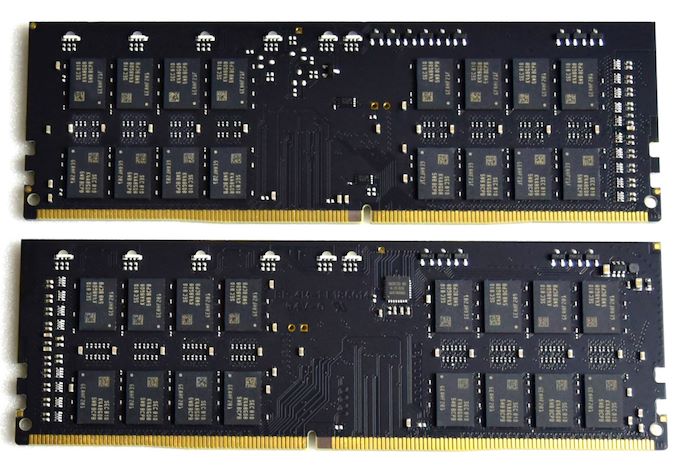
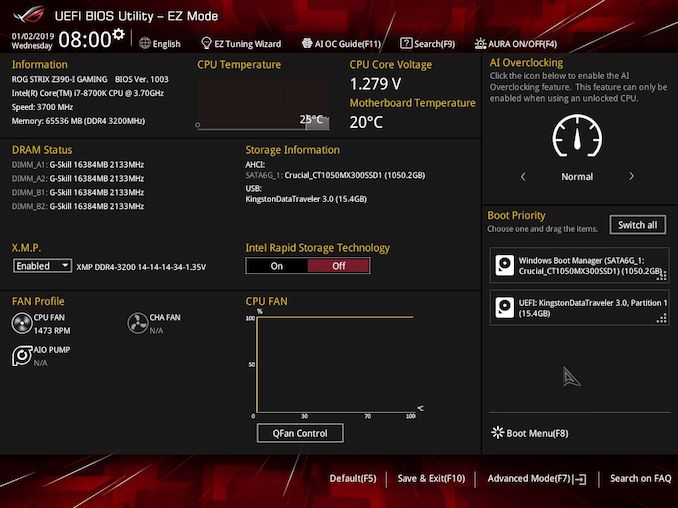
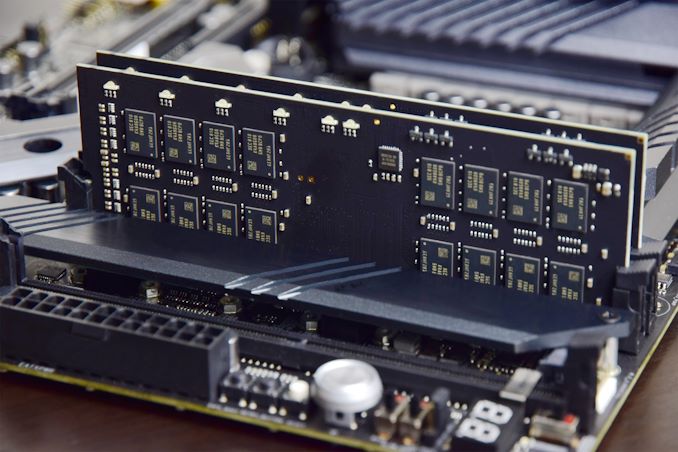








50 Comments
View All Comments
Alim345 - Wednesday, January 23, 2019 - link
It’s not clear whether it is possible to use four sticks. Probably it is not since those sticks replicate what should happen in motherboard.Targon - Thursday, January 24, 2019 - link
Much of that would be a function of the chipset/BIOS and the memory controller which is on the CPU these days. These double height modules can't directly talk to the memory controller as if they are two modules, because the memory slots themselves and how they talk to the chipset/memory controller/CPU are not different.That is why I wanted to see at least an attempt to get these to work with a socket AM4 system and see how they show up. Going from 1T or 2T to 2T or 4T for the memory is probably the issue, and if the chipset would even allow it. Asking Asus if they have plans to allow DDR4 to run with a 4T command rate on more boards would be worth the call.
nevcairiel - Wednesday, January 23, 2019 - link
Since one of those DIMMs basically acts like two DIMMs, you probably cannot use two of them on the same channel, since that would require supporting 4 DIMMs on the same channel.Targon - Thursday, January 24, 2019 - link
I don't think it works that way. Yes, internally each one is working as if it was two, but how the module talks to the BIOS/chipset/processor is the big question. Does the BIOS need to support a 4T command rate on the memory for these to work, and if so, that explains why support is limited.Bp_968 - Thursday, January 24, 2019 - link
He explained in the article that the way memory channels are handled that the traces are daisy chained or combined. These dimms act as 2 dimms slapped onto one card and won't work stacked 2 too a channel (because then you'd have 4 dimms on a channel).Above and beyond that you also have the fact that now 32GB modules exist which render these far less useful. There are very very few scenarios where you'd want 128GB of ram and not want it to be ECC RAM. Any sort of server and many workstation tasks I'd much prefer to use ECC ram instead.
yuhong - Wednesday, January 23, 2019 - link
Even Intel don't usually update ARK or the datasheet.alpha754293 - Wednesday, January 23, 2019 - link
Maybe I'm missinng something here - but I don't understand why people just don't get 32 GB DDR4-2666 ECC Registered DIMMS like this one (https://www.newegg.com/Product/Product.aspx?Item=N... and be done with it?It's going to run about the same price and they can just overclock it.
Wixman666 - Wednesday, January 23, 2019 - link
Because most boards don't run ECC memory. These are a niche product to get 64GB on boards that only have 2 slots. Lots of memory doesn't overclock well. You're making assumptions with your statement that are completely off base.CheapSushi - Thursday, January 24, 2019 - link
Does that mean ECC RAM will NOT WORK AT ALL or just the ECC portion, soft error correcting, won't work but it'll show up like regular RAM?alpha754293 - Thursday, January 24, 2019 - link
I've used ECC memory on consumer grade boards. All that happens is that the ECC part of the ECC, Registered RAM gets disabled and the rest of the DIMM module functions like a UDIMM instead of a RDIMM."You're making assumptions with your statement that are completely off base."
Yes! Which is why I literally said: "Maybe I'm missinng something here - but I don't understand why people just don't get 32 GB DDR4-2666 ECC Registered DIMMS like this one (https://www.newegg.com/Product/Product.aspx?Item=N... and be done with it?"
Lots of memory don't overclock well is just a broad and generic statement that can also be applied to these modules as well.
The fact of the matter is that DDR4-3000 and DDR4-3200 modules ARE overclocked by default anyways because those speeds aren't part of the JEDEC JESD79-4 spec (p.163).
Here is a 32 GB module from Micron Technology, DDR4-3200, ECC Registered: https://www.ebay.com/itm/Micron-MTA36ASF4G72PZ-3G2...
The point being that a) they exist already and b) you should be able to disable the ECC, registered capabilities of these DIMMs. (I've never had a consumer grade board that didn't know how to ignore the ECC registered capabilities of RDIMMs.)
In other words, you can already do this with existing modules that you can buy, at those speeds, "second" hand (which tells you a little bit about the maturity of the tech).